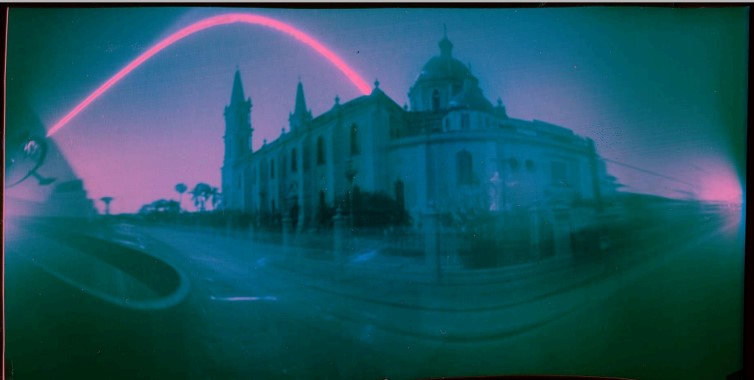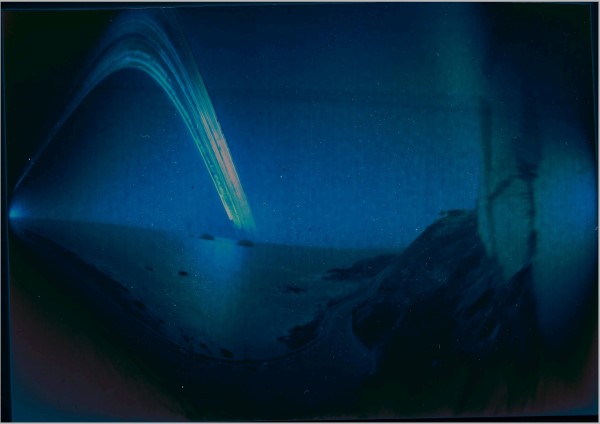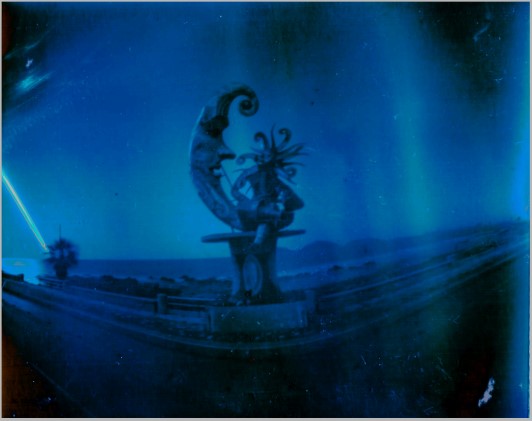This is a photographic series made with experimental technique from Mazatlán.

Capturing the iconic places of the port of Mazatlán and its surroundings through an unconventional photographic approach inspired Daniel López Bravo to look for new techniques and tools, in this case, solarigraphy.
Solarigraphy is a photographic practice based on observing the path of the sun in the sky and its effect on the landscape, through long exposures of light that can last for days and up to six months.
The interesting thing about this is that it is not necessary to use a recently created analog or digital camera on the market, but simply a homemade camera (pinhole) made with any can – in Daniel’s case, a can of Pacífico beer – and photographic paper attached.
Photograph of the old Pino Suárez market in Melchor Ocampo, Centro, 82000 Mazatlán, Sin. 4 days of exposure in winter (05-09/11/23) thus being able to capture the morning sun until its zenith and setting, with the medium format camera placed on the opposite corner to the market at a traffic light.

With all this, the artist developed an artistic project and applied to the Program for the Stimulation of Artistic Creation and Development (PECDA), where he was supported with a scholarship. The result of this was “Solarigraphs of the port”, a photographic series made with experimental technique from Mazatlán.
The Carpa Olivera beach resort, the Mazatlán cathedral, the Pino Suárez market, the monument to the bichis monkeys, the dolphin monument, the Paseo del Centenario and even Cerritos Beach during the last solar eclipse, are some of the landscapes that the artist managed to record with his canister camera.
“I started experimenting about 2 and a half years ago, it is a practice that requires a lot of patience to then begin to understand how it works, although later I feel that the canister cameras end up doing what they want, because one leaves them there and they are exposed to being modified by the weather or someone moving them,” he explains.

Solarigraphy on the coastal road of the Paseo del Centenario, 2 weeks (13-27/03/24) of exposure pointing to the sunset sun. Medium format device placed on the wall of the stairs of the lookout. Just below the sunset line you can see the two white stones. And in the foreground the curvature of the street and part of the wall of the lookout.
“Sometimes you take out the paper and suddenly there is nothing, it is strange, the way that type of photography works is very volatile, that is why I think it is good to name it as experimental,” he comments.
Another part that is very difficult about the procedure, says Daniel López, is that since the can camera has to be left for several days focused on the lens, sometimes it is common for people to move it or for it to simply not be there when you go to get it, as it is easily confused with trash.
“The thing is to leave the camera in a place where people will not move it, if it moves, the variation is recorded and it loses focus,” he says.

MONIGOTE ON MALECÓN
Carnival 2024 puppet solarigraphy. 2 days of exposure (03/20/24) pointing to the three islands. Medium format device placed on a palm tree on the median strip, right in front of the sister cities park. On the left side we can see the sun’s ray at sunset.
“Solarigraphs of the port” is a photographic project that produced a series of images that show in 6 months of exposure the path of the sun across the sky of Mazatlán at the winter to summer solstice, having the Mazatlan landscape as an element and exposures of a few days with large format cameras pointing to the emblematic monuments of the city.
Source: revistaespejo







